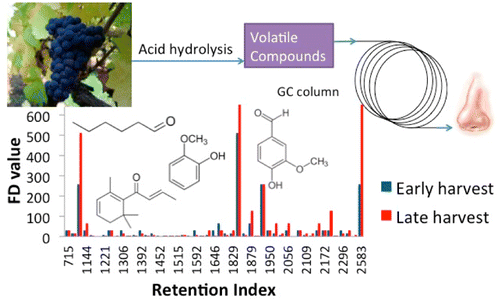Toward consistently good pinot noir

The grapes used to make pinot noir, the red wine of hit comedy "Sideways" fame, are known to be literally and figuratively thin-skinned. They're highly sensitive to their environment, making it difficult for growers to determine their quality at harvest time. To get a better handle on the finicky fruit, scientists have now figured out how the grapes' aroma profile changes as they ripen. Their report appears in ACS' Journal of Agricultural and Food Chemistry.
As any wine connoisseur knows, aroma is a critical component to a vintage's quality. It changes as a grape matures, and ultimately, the blend of aroma-related compounds when the fruit is plucked from the vine determines how good the resulting wine is. But the current analytical techniques used to tell whether a wine grape is ready to be picked rely on sugar content and acidity. Michael C. Qian and Fang Yuan wanted to develop a way to determine maturity based on aroma.
The researchers identified 49 main odor compounds in young and ripe pinot noir grapes from two consecutive years, 2012 and 2013, using a technique called gas chromatography mass spectrometry. Of those, four were consistently found in mature grapes. Their results could help growers figure out the best time to harvest their crop and ensure its quality.
More information: Fang Yuan et al. Aroma Potential in Early- and Late-Maturity Pinot noir Grapes Evaluated by Aroma Extract Dilution Analysis, Journal of Agricultural and Food Chemistry (2016). DOI: 10.1021/acs.jafc.5b04774
Abstract
Aroma potentials in early and late maturity Pinot noir grapes were investigated in two consecutive vintages. The grape samples were hydrolyzed under acidic conditions, and the released odorants were studied by aroma extract dilution analysis (AEDA). Forty-nine main odor-active compounds were detected in the AEDA. The odorants released with high flavor dilution values were 1-hexanal, β-damascenone, guaiacol, and vanillin, together with C6-aldehydes and -alcohols, 4-vinylguaiacol, 4-vinylphenol, and 1-octen-3-one. The concentrations of aroma-active compounds were further quantitated. Compared with early harvest grapes, late harvest grapes released more β-damascenone, vanillin, 4-vinylguaiacol, and 4-vinylphenol in both years according to both AEDA and quantitation results, suggesting they were important aroma compounds that contribute to the characteristic of matured Pinot noir grapes.
Journal information: Journal of Agricultural and Food Chemistry
Provided by American Chemical Society





















